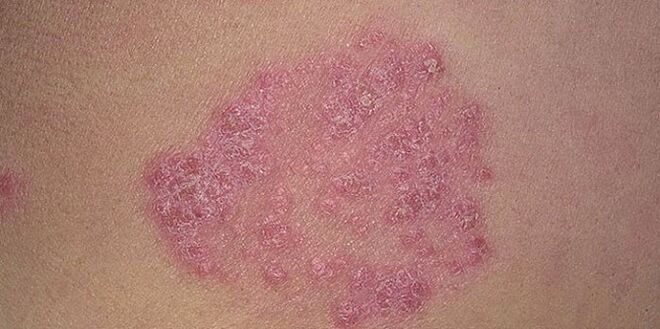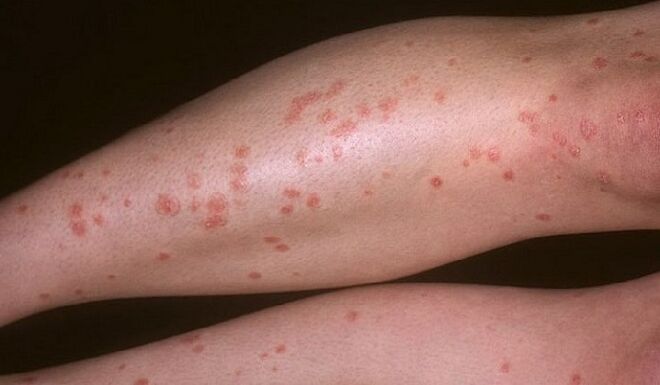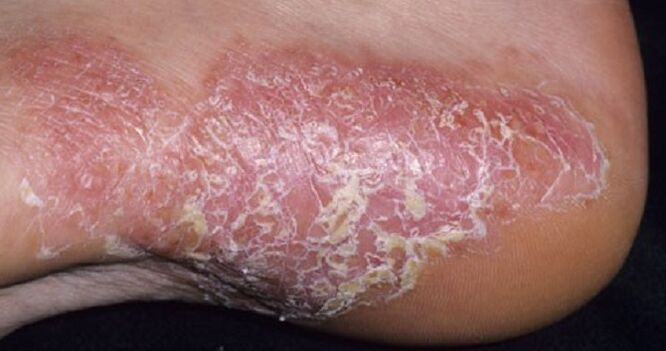Psoriasis of the foot is a skin disorder in which itchy papules, spots or pustules appear on certain parts of the limbs. Over time, they grow and coalesce into plates. This disease is incurable and chronic. A well-designed complex therapy helps to quickly relieve the symptoms of foot psoriasis. Therefore, wanting to achieve a lasting forgiveness (to cleanse the skin completely or partially from the elements of redness), you should not prescribe treatment for yourself.
Causes of pathology
Scientists still do not understand why psoriasis appears on the feet and other parts of the body. Many researchers associate psoriatic skin rash with a genetic dysfunction in epidermal cells and excessive subsequent activity of the immune system. This pathological condition occurs as follows:
- As a result of skin dysfunction, keratinocytes (make up 90% of epidermal cells) do not have time to mature, but at the same time they multiply rapidly, which leads to a change in the structure of individual skin areas.
- In response to such a failure, the body's immunity sends T lymphocytes (killer cells) and macrophages (eating cells) to destroy immature and pathologically altered keratinocytes.
- As a result of the accumulation of a large number of immune cells and keratinocytes in the upper layers of the epidermis, the skin grows and begins to peel. No medicine can help completely normalize skin rejuvenation functions.
Progression of foot psoriasis is facilitated by a bacterial infection that can penetrate the skin through minor scratches, as well as a disturbed hormonal background, allergic contact dermatitis, and a number of other external factors.
What does foot psoriasis look like, depending on the type of disease
Psoriatic lesions on the feet and knees of the feet may look different from person to person. This factor is explained by the cyclical course of the disease. In addition, one or more forms of psoriasis can develop on the skin of the feet, including the palm-toe, common (vulgar), tear-shaped, perforated, as well as nail and joint psoriasis.
Psoriasis of the feet and legs
Elements of psoriatic rash can be localized to different parts of the skin of the feet:
- on the knees;
- on the shin;
- on the heel;
- in the thigh.
Psoriasis of the lower leg, foot, knee joint, and inner thigh begins with the appearance of single red papules and severe itching (typical of the vulgar spot and form of the disease) or with small pink and purple spots. (with tear-shaped psoriasis).

In the first case, the blush elements protrude slightly above the surface of the skin, vary in density, and have a peak with a silver scale, which is hidden when itching with the fingernail. Over time, the papules grow, and those that are close together merge into a single plaque. As a result, they completely cover the skin of the knees or cover solid areas of skin from the knees to the feet. Peeling appears on the surface of the tiles.

In the initial stage, the teardrop-shaped elements of psoriatic rash affect the entire skin of the feet with the same type of small rash. Then, as the disease progresses, the single spots join in clusters and cover large areas of skin on the foot. Such psoriatic lesions rarely occur in the heel.

Palmar-plantar psoriasis often develops in the sole of the foot. Rash elements form on the inflamed skin of the feet in the form of small spots and pustules with clear borders and sterile yellow contents. If the pustules on the foot open, then the fluid from them flows out, dries and forms a yellow crust, the ulcers under it also dry out.
Pustules that do not crack are covered with dry scales. Gradually, they grow and combine in groups, the scaly layer begins to tighten the skin tightly, which causes discomfort while walking. The skin around the plates becomes thick and dry, cracking. Through such cracks, an infection usually penetrates into the deeper layers of the dermis, after which the skin begins to cry and break down.
Psoriatic arthritis
In most cases, psoriatic plaque of the feet provokes psoriatic joint damage. This arthritis is divided into 5 types:
- Symmetrical - simultaneous inflammation of the paired joints of the knees, hip region, ankles or feet.
- Asymmetric - pathological changes affect both large and small joints, for example, the joints of one knee and the joints of the fingers.
- Inflammation of the distal joints - the small joints in the fingers closest to the nails swell.
- Spondylosis - Arthritis affects the lumbosacral spine, resulting in pain in the hips and lower extremities.
- Deforming arthritis is a rare inflammatory pathology in which the small joints of the fingers are completely destroyed.
The skin over the swollen joints swells, becomes purple-blue and becomes hot.
Damage to nail plates
Psoriatic nail damage occurs against the background of:
- psoriatic arthritis in 80-90% of cases;
- vulgar or pustular psoriasis in 50-60% of cases.
In 5-10% of clinical cases, psoriasis of the toenails is primary, ie it appears on its own, it is not preceded by psoriatic lesions of the joints or skin of the feet.
Initially, common psoriasis on the soles of the feet or psoriatic inflammation of the distal joints of the toes cause pathological changes in the skin of the periungual region. Then the pathology spreads to the nail bed or touches the nail plate lying on it. There is a deformation of the nail - the formation of scratches, diagonal lines - and a stain on the plate.
Similar signs of psoriasis in women are rarely seen in youth, more often the disease appears in young people. In old age, psoriatic nail damage affects both women and men equally.
Stages of progress
Psoriasis of the lower extremities, if left untreated, goes through 3 stages of development:
- beginners;
- progressive;
- stationary.
After that, the pathological changes are suspended, the remission phase begins. Without preventive treatment, the disease resumes over time.
The manifestation of the initial stage of the disease in the foot is characterized by the formation of a small single rash, in the form of spots, papules or pustules. At first, it can occur in the bends of both knees at the same time. The blush elements are red or pink, then their tops are covered with white scales. The initial stage of psoriasis lasts about 3 weeks. During this time, the papules or pustules increase in size and combine into clusters.
The initial stage of psoriasis can be stopped if you seek help immediately from a specialist. But more often than not, people ignore the symptoms of the onset of the disease, which is why psoriasis continues to develop. In a progressive stage, the number of psoriatic plaques on the skin of the feet increases, those that are close to each other merge into "paraffin lakes" of different shapes and sizes. Psoriasis on the toes leads to inflammation and desquamation of the periungual tissue and damage to the nails.
For the progressive period, the Kebner phenomenon is characteristic, when a psoriatic rash forms on the healed skin, for example, after a cut or scratch.
In the immobile phase, psoriasis of the feet and other areas of the skin of the feet still manifests as severe itching and shaking. However, new blush elements no longer appear, and the plaques stop growing in size. There are no inflammatory edges around them; dry scales appear instead. If treatment is stopped at this stage, the disease will start to get worse again. Otherwise, the psoriatic plaques stop peeling, some of them disappear completely, some simply light up - the remission phase begins.
How to treat foot psoriasis
The treatment regimen for foot psoriasis is compiled for each patient separately, taking into account the location of the rash, the form of the disease, the stage of progression and a number of other factors. Dangerous it is dangerous to independently invent a treatment for this disease, because complications can appear in the form of extensive skin lesions, inflammation of the joints, up to their destruction and the addition of a bacterial infection (staphylococcal, streptococcal).
treatment
First, the foci of psoriasis are affected by non-hormonal ointments:
- tar, naphthalene - oils relieve inflammation, are antiseptic, but they should be used only as directed by a doctor, as they have serious contraindications.
- sulfur oil - salicylic, salicylic acid - refer to keratolytic agents (destroying the corneal layer). They have an exfoliating effect and help the plates to digest.
- oils containing solidol, soften the skin of the feet, have a regenerating effect.
- ointments containing the active form of vitamin D3 slow down the process of cell division, thus reducing inflammation and skin rash on the feet.
If non-hormonal medications do not help stop psoriasis of the feet, then corticosteroid oils are prescribed, which are divided into:
- Weakly active - the funds act on the surface of the skin, suitable for the initial stage of psoriasis. Some ointments of this group are approved for use by children, pregnant women and those who are breastfeeding.
- Moderately active - prescribed for the treatment of psoriasis on rough skin areas of the feet, in particular, on the knees and heels.
- Very active - prescribed if moderately oily oils can not stop the growth of psoriatic plaques on the skin of the feet.
If no ointment for psoriasis helps, then in the advanced stage of the disease, the pills are prescribed simultaneously with external medications for:
- suppression of immune cell activity;
- preventing the spread of epidermal cells;
- they also receive retinoids - derivatives of vitamin A, needed to restore epidermal cells.
How to get rid of foot psoriasis with home methods
Popular remedies for psoriasis are medicines for external and internal use, but in treatment they should be used with caution as medicines.
Questions like how to cure psoriasis at home for good are still unanswered. Some home-made recipes help to remove the symptoms of the disease for a long time, but not to get rid of them completely.
Aggravating ointment
Ingredients:
- unrefined sunflower oil - 1 liter;
- celandine herb - 50 g;
- elecampane roots - 50 g;
- acetylsalicylic acid - 50 tab.
How to prepare: grind tablets and herbs using a coffee grinder, pour the resulting powder into vegetable oil, mix thoroughly. Leave for 30 days in a warm, dark place to fill. During this period, the mixture should be heated every 3 days in a steam bath, stirring, but not boiling.
How to use: strain the drug, mix the resulting liquid with Vaseline (3: 1), apply 3 times a day on psoriatic tablets.
Ointment that relieves symptoms in 10 days
Ingredients:
- birch tar - 150 g;
- pharmacy alcohol - 150 mg;
- camphor oil - 75 mg;
- chicken yolk - 3 pcs.
How to cook: Beat the yolks in an enamel bowl, gradually adding camphor, then tar and alcohol. Store the oil in a dark place.
How to use: Apply with a gauze pad to the inflamed skin of the feet. After three days, you should wash your feet with warm water with a tar soap scrub, wipe off the moisture and apply the oil again for 3 days. If the disease does not start, then the procedure is repeated again, after which the skin is cleansed.
During the period of treatment with home ointments, it is very important to maintain the body's immunity. For this purpose, 1 tablespoon can be taken orally per day. sea buckthorn oil.
Diet
Proper nutrition is one of the conditions for effective treatment of psoriasis not only on the feet but also on other parts of the body. Medical scientists concluded that the allergic factor contributes to the progression of all forms of psoriasis, so allergic foods should be excluded from the menu first of all:
- chicken eggs;
- seafood;
- natural honey;
- chocolate, cocoa;
- grapes;
- lamb;
- pork;
- Chicken meat;
- alcohol.
During this period, it is very important to give up sweet, spicy, very salty and smoked foods - they slow down the metabolism in the body. The menu should include dairy products, river fish, cereals, baked apples, vegetable oils, green peas, carrots.

Complete starvation for psoriasis, when a person drinks only one water, is contraindicated.
During a worsening of foot psoriasis, doctors recommend arranging a day of fasting once a week, for example, eating only apples, kefir or boiled river fish.
Physiotherapy
The answer to the question of how to treat foot psoriasis with physiotherapy is quite broad. To this end, doctors prescribe:
- Ultrasound therapy - ultrasonic waves emanating from the device cause compression and stretching of skin tissues, which is done to restore their cells. Thus, it is possible to relieve inflammation, itching and swelling from the skin of the feet.
- Elektrosleep - prescribed for psoriasis of the skin of the feet, if a person can not cope with the stress caused by the pathology.
- Phototherapy - under the influence of ultraviolet rays, the skin's immunity is strengthened, the rate of growth and cell division is reduced.
To improve metabolic processes in the skin of the feet with psoriasis, acupressure helps. It is recommended to perform it only during the remission period of the disease, otherwise there is a high probability of infection in the inflamed skin.
Hygiene rules
In order not to cause the appearance of new psoriatic plaques on the skin of the feet, during the remission period it is recommended to use only warm water and baby toilet soap with a moisturizing effect for washing the skin. When the disease progresses, the feet should be washed with warm water and tar soap, which not only cleanses the skin but also removes inflammation from it. After washing, dry the skin and toenails thoroughly with a soft towel.
Additional recommendations
Treatment for foot psoriasis will be long-term if a person:
- He is engaged in an active sport - his feet sweat, he has a large load on his feet. After exercise, it is very important to wash your feet with lukewarm water, dry them thoroughly, wear clean socks and loose shoes that will allow your skin to breathe.
- Exposed to the sun regularly and for a long time - excessive sunlight causes burns and damages metabolic processes in the skin. In the advanced stage of psoriasis on the skin of the feet, it is better to refuse abundant sunbathing, and in the period of remission, you should use a protective cream.
Preventive measures and prognosis
Today, psoriatic disease is considered incurable. Therefore, once a sustained reduction of symptoms has been achieved, efforts should be made to maintain this condition in the manner recommended by the physician. There is no room for self-medication here.























